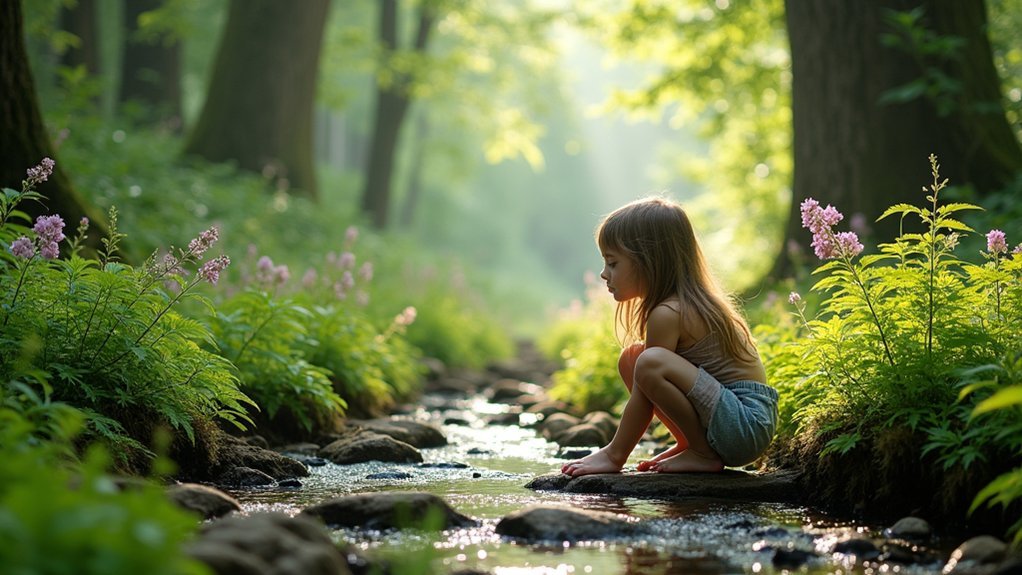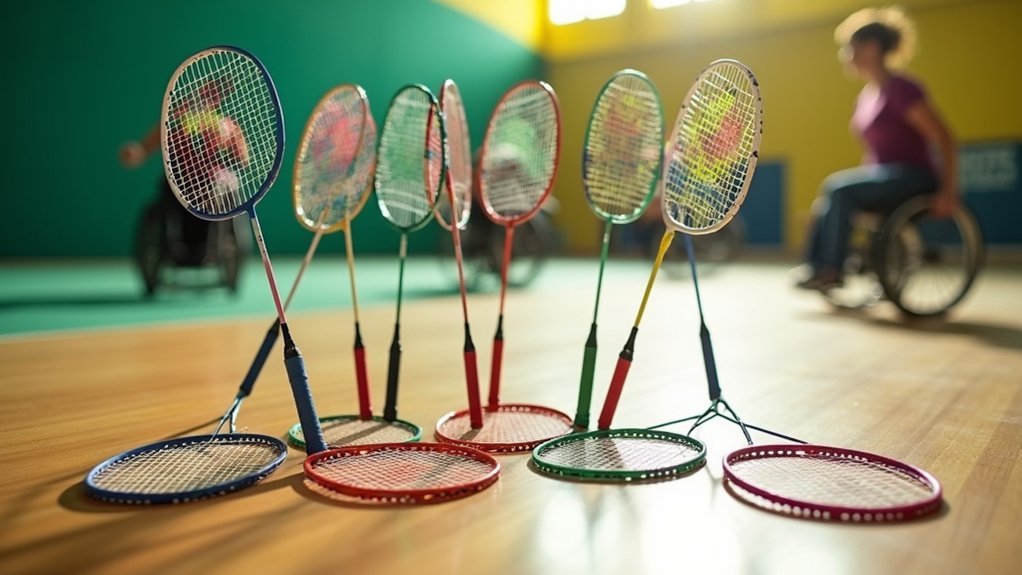Nature offers powerful healing benefits for children with autism, reducing anxiety through gentler sensory experiences than indoor environments. You’ll find that natural settings improve emotional regulation, enhance social skills, and provide therapeutic sensory stimulation through varied textures and sounds. Green spaces can decrease stress levels while activities like forest bathing and animal interactions foster communication development. The right outdoor experiences, with appropriate accommodations for sensory needs, reveal remarkable developmental potential for those on the spectrum.
The Healing Power of Nature for Autism

While traditional therapies remain important for autism treatment, nature’s healing influence offers unique benefits that can’t be replicated in clinical settings. When your child with ASD spends time outdoors, they experience measurable emotional, social, and cognitive improvements that enhance their overall development.
Natural environments provide powerful therapeutic opportunities that align with Attention Restoration Theory, helping your child regain cognitive focus and reduce anxiety. You’ll likely notice improved communication skills as they engage with nature through activities like gardening or outdoor play.
Nature’s restorative power offers your child with autism a unique pathway to improved focus, reduced anxiety, and enhanced communication skills.
Despite challenges like sensory sensitivities that can limit access to outdoor spaces, specialized nature-based interventions—including equine therapy and sensory gardens—have proven highly effective.
These natural settings create calming experiences that promote emotional well-being while developing essential social skills for children with autism.
Understanding the Sensory Benefits of Natural Environments
Because children with autism often struggle with sensory processing, natural environments offer a uniquely balanced sensory experience that’s difficult to achieve indoors. When you introduce children with autism spectrum to these settings, they encounter stimuli that engage their senses without overwhelming them.
- Nature exposure provides gentle, predictable sounds like rustling leaves versus jarring indoor noises.
- Natural lighting doesn’t flicker or buzz like artificial alternatives, reducing visual stress.
- Outdoor textures (grass, sand, water) offer therapeutic benefits through varied tactile exploration.
- Animals in nature create opportunities for emotional regulation through calm, non-demanding interactions.
These natural environments help children navigate sensory processing challenges more effectively than typical indoor settings, creating spaces where they can engage comfortably with their surroundings and develop coping strategies.
How Green Spaces Reduce Stress and Anxiety in Children With ASD

The calming embrace of green spaces offers powerful relief for children with ASD who frequently battle heightened stress and anxiety.
When you introduce your child to natural environments, you’re providing a therapeutic alternative to overstimulating indoor settings that can trigger sensory overload.
Research confirms that nature exposure notably enhances emotional resilience by activating positive emotional responses.
Parents consistently report improvements in attention deficits following time outdoors, with green spaces creating opportunities for more relaxed social interactions.
Stress Recovery Theory explains why this works: natural environments promote restoration from stress that’s particularly beneficial for children with Autism Spectrum Disorder.
The unstructured quality of outdoor play allows your child to engage with the world on their terms, fostering stress reduction and improved overall well-being.
Designing Accessible Nature Trails for Diverse Abilities
Creating truly inclusive outdoor experiences requires thoughtful trail design that accommodates children across the autism spectrum. When you’re designing accessible nature trails, consider sensory sensitivities by incorporating quiet zones and using sensory-friendly materials that won’t overwhelm children with autism.
- Install clear signage with visual aids and tactile elements to support navigation and independence.
- Develop smooth, wide paths that welcome mobility devices and guarantee everyone moves comfortably.
- Integrate natural play areas with interactive installations to encourage exploration and engagement.
- Partner with caregivers and autism specialists during planning to address specific needs.
Inclusive design isn’t just about physical accessibility—it’s about creating environments where children with diverse abilities can connect with nature on their own terms.
Through thoughtful collaboration with caregivers, you’ll develop spaces that truly serve everyone.
The Role of Natural Soundscapes in Sensory Integration

While many therapeutic approaches focus on structured environments, natural soundscapes offer unique benefits for children with autism seeking sensory integration support. When your child listens to birdsong or rustling leaves, these soothing auditory stimuli can greatly reduce anxiety and promote relaxation.
You’ll notice improved sensory integration as natural soundscapes help your child process environmental information more effectively. The rhythmic, predictable patterns of nature’s sounds create a sense of security that enhances emotional regulation.
These calming effects also boost attention and focus—crucial skills for children who struggle with concentration.
Consider incorporating natural soundscapes into therapeutic settings. Whether through recorded sounds or direct nature exposure, these auditory experiences can complement traditional therapies, fostering better social interaction and emotional stability for your child with autism.
Forest Bathing: A Therapeutic Approach for Autism
Moving beyond auditory experiences, forest bathing offers an extensive therapeutic approach that engages all senses for children with autism. This Japanese practice of “Shinrin-yoku” provides remarkable therapeutic benefits for those with autism spectrum disorder by lowering cortisol levels and enhancing emotional regulation in a natural setting.
You’ll find nature-based interventions like forest bathing particularly effective because they align with attention restoration theory, reducing cognitive fatigue while improving focus in a non-intrusive environment.
- Immersion in forest environments greatly reduces anxiety and stress, addressing common challenges in autism.
- Sensory exploration in nature creates opportunities for improved social skills and communication.
- The calming forest atmosphere helps balance sensory sensitivities often experienced with ASD.
- Regular forest bathing may increase oxytocin levels, fostering deeper social connections and trust.
Structured Outdoor Activities That Support Social Development
Structured outdoor activities offer powerful opportunities for children with autism to build essential social skills while enjoying the benefits of nature.
You’ll find that group nature scavenger hunts and gardening projects encourage collaborative problem-solving and communication as children work together toward common goals.
Consider incorporating team challenges that leverage the calming effects of outdoor environments, creating comfortable spaces where children with autism can practice social interaction without the overwhelming stimuli often present indoors.
Group Nature Scavenger Hunts
As children with autism explore the natural world together during group scavenger hunts, they develop essential social skills in an environment that feels both exciting and safe.
These sensory-friendly activities foster emotional regulation while encouraging communication skills through collaborative problem-solving.
You’ll notice your child’s confidence grow as they connect with peers and nature simultaneously.
Group nature scavenger hunts provide structured yet flexible opportunities for cognitive development through exploration and discovery.
- Create teams that balance children’s abilities, encouraging mutual support
- Use visual cards with pictures of items to find, making instructions clear
- Incorporate different sensory elements—like textures, sounds, and colors
- Celebrate each discovery together, reinforcing social interaction and shared joy
Gardening With Peers
Four distinct benefits emerge when children with autism participate in group gardening activities.
First, they develop essential social skills as they collaborate on planting projects, learning to share tools, take turns, and communicate their ideas with peers.
Second, gardening fosters emotional well-being by creating a calming environment that reduces anxiety and stress levels.
Third, these structured outdoor activities help children develop fine motor skills while manipulating plants and tools, building confidence through visible accomplishments.
Finally, gardening offers rich sensory exploration opportunities through various textures, colors, and scents that enhance sensory processing abilities.
As children with autism work together in garden spaces, they naturally form stronger peer relationships through shared experiences and common goals, creating a supportive community where social development thrives alongside beautiful plants.
Outdoor Team Challenges
Nature-based team challenges offer remarkable benefits for children with autism, creating structured opportunities to develop essential social skills while enjoying the outdoors.
These activities provide a less stimulating environment where children can practice social interactions without feeling overwhelmed.
You’ll notice significant improvements in your child’s emotional regulation and peer relationships as they engage in these structured outdoor activities.
Children with autism often demonstrate enhanced cognitive functioning and problem-solving abilities through nature-based team activities.
- Scavenger hunts that require communication and collaboration
- Obstacle courses that encourage taking turns and supporting peers
- Nature-based building projects that develop shared focus
- Low-pressure team games that foster social development without competition
These challenges create a supportive setting where children can develop confidence in social situations while enjoying the calming effects of nature.
Therapeutic Gardens: Creating Safe Spaces for Sensory Exploration
Within the domain of natural therapy for autism, therapeutic gardens stand out as havens where children can safely explore the world through their senses.
You’ll find these spaces deliberately designed with diverse plants, textures, and interactive elements that cater to various sensory preferences, creating opportunities for meaningful exploration through touch, smell, and sight.
Research shows these gardens markedly improve social interaction while reducing anxiety in children with autism.
When your child participates in gardening activities, they’re developing a sense of responsibility that boosts self-esteem. The unstructured play environment fosters essential life skills like communication and teamwork.
You’ll appreciate how therapeutic gardens provide a calming retreat from overstimulating environments, helping your child with emotional regulation while experiencing the restorative embrace of nature—a powerful combination for their overall well-being.
Overcoming Barriers to Nature Access for Families Affected by Autism
Despite the well-documented benefits of nature exposure, families affected by autism often encounter significant obstacles when attempting to access green spaces.
Nature’s healing touch remains inaccessible to many autism families facing barriers to green space engagement.
Sensory challenges, concerns about disruptive behaviors, and safety issues can deter you from exploring the outdoors with your child.
To help overcome barriers to nature access:
- Start with short, low-pressure visits to quiet green spaces during less crowded times
- Create a visual schedule or social story about the outdoor experience to reduce anxiety
- Bring familiar comfort items to help manage potential sensory overload
- Connect with other autism families to develop supportive group outings
Nature-Based Interventions and Their Evidence-Based Outcomes
Once you’ve found ways to access natural environments with your child, you’ll likely want to understand how these experiences can specifically benefit autism-related challenges.
Research consistently shows that nature-based interventions improve social interaction, communication, and behavior in children with autism spectrum disorder.
Natural environments provide calming, non-intrusive sensory experiences that contrast with overwhelming indoor settings, enhancing emotional well-being.
Studies link community tree canopy coverage to decreased conduct problems, while nature contact reduces impulsivity and inattention—similar to benefits seen in children with ADHD.
Therapeutic activities like equine-assisted therapy and sensory gardens have demonstrated significant effectiveness in improving social functioning.
These settings allow your child to engage at their own comfort level, creating positive experiences that translate to measurable improvements in autism-related behaviors and emotional regulation.
Seasonal Considerations for Outdoor Therapy Programs
As you plan nature-based activities for your child with autism, the changing seasons offer unique opportunities and challenges that can greatly impact therapeutic outcomes.
Seasonal variations directly influence sensory experiences during outdoor therapy sessions, requiring thoughtful adaptation to maximize benefits year-round.
- Spring/Summer: Leverage gardening activities to develop fine motor skills and promote sensory integration through contact with soil, plants, and pollinators.
- Fall: Utilize the changing environment to create sensory-rich experiences with colorful leaves, varied textures, and natural sounds that support emotional well-being.
- Winter: Prepare indoor alternatives or sheltered spaces when cold temperatures might trigger sensory overload or discomfort.
- Year-round: Incorporate seasonal themes into your therapy program to build connection with nature’s cycles and enhance predictability for your child.
Equine and Animal-Assisted Therapies in Natural Settings
When your child with autism connects with horses in natural settings, they’ll often experience profound emotional bonds that traditional therapies can’t replicate.
These animal interactions in nature provide multi-sensory experiences that help regulate your child’s nervous system while building essential social skills through non-verbal communication.
The outdoor environment amplifies these benefits, as your child processes the therapeutic movement of horses alongside the calming sights, sounds, and textures of nature.
Horses Foster Emotional Connection
Though many therapeutic approaches exist for children with autism, equine-assisted activities stand out for their remarkable ability to forge emotional bonds in natural settings.
When your child interacts with horses in calming outdoor environments, they’re engaging in powerful nonverbal communication that reduces sensory overload and builds trust naturally.
- Your child’s interactions with horses can greatly improve their social functioning while reducing aggressive behaviors.
- The special bond formed between your child and horses may increase oxytocin levels, enhancing emotional connection.
- Equine therapy provides opportunities for your child to develop empathy through understanding the horse’s reactions.
- These meaningful interactions often lead to improved self-esteem and emotional well-being.
This natural approach to bonding creates a unique pathway for children with autism to develop essential social and emotional skills in a supportive, anxiety-reducing environment.
Nature-Based Animal Interactions
The healing bond between children with autism and horses represents just one facet of nature’s therapeutic potential. When you place these animal interactions within natural settings, you’re creating uniquely calming environments that can greatly improve your child’s experience with autism spectrum disorder.
Research shows that nature-based animal interactions markedly enhance social functioning while reducing aggressive behaviors. Your child develops emotional regulation skills through nonverbal communication with animals, forming connections that might be challenging in human relationships.
The sensory experiences offered in natural settings prove more soothing than traditional therapeutic environments.
There’s science behind these therapeutic benefits too—caring for animals increases oxytocin levels in children with autism, promoting emotional bonding and reducing anxiety.
These outdoor animal interactions create a thorough approach that addresses both emotional and social development in ways traditional therapies alone can’t match.
Sensory Benefits Outdoors
Natural environments offer remarkable sensory benefits for children with autism, especially when paired with animal interactions. When you expose your child to nature’s diverse stimuli alongside therapeutic activities with animals, you’re providing a controlled yet enriching sensory experience.
Nature provides a calming backdrop that can help regulate the sensory challenges often experienced in autism spectrum disorder.
- Touch sensations vary naturally—from a horse’s coat to grass beneath bare feet—without overwhelming the senses.
- Sound experiences in nature offer gentler shifts than indoor environments.
- Visual stimuli in outdoor settings create interest without the harsh lighting of indoor spaces.
- Movement opportunities with animals encourage balance and coordination development.
These combined sensory experiences support emotional health through regulated, meaningful interactions that build confidence and reduce anxiety.
Frequently Asked Questions
How Does Nature Help With Autism?
Nature helps with autism by restoring your focus, reducing anxiety, and improving social interactions. You’ll benefit from engaging outdoor environments that calm sensory overload and provide therapeutic animal interactions supporting cognitive development.
What Is 90% of Autism Caused By?
Research indicates that 90% of autism risk stems from genetic factors. You’ll find it’s not a single gene but multiple genetic variations that contribute to ASD development in most cases.
What Plant Is Used to Treat Autism?
No plant directly treats autism. You’ll find some herbs like St. John’s Wort, valerian root, and chamomile may help manage associated symptoms like anxiety. Cannabis oil and omega-3 rich plants are being researched for potential benefits.
Who Carries the Autism Gene, Mother or Father?
Both your mother and father can carry genetic variants linked to autism. It’s not a single gene but multiple genetic factors from both parents that contribute to autism’s complex inheritance pattern.
In Summary
You’ve seen how nature can transform your child’s autism experience. When you embrace these green interventions, you’re giving them essential sensory benefits while reducing anxiety. Don’t let barriers prevent access to these healing spaces. Start small—a local park visit or backyard exploration can make a difference. Nature isn’t just a nice-to-have; it’s a powerful, accessible therapy that works with your child’s unique needs.





Leave a Reply